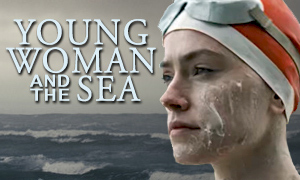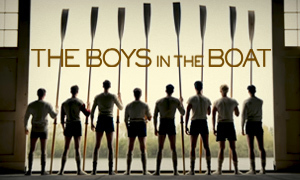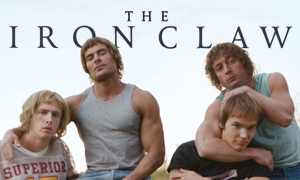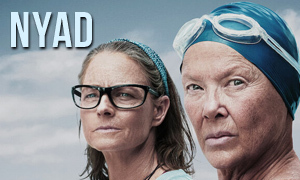Race: History vs. Hollywood
| REEL FACE: | REAL FACE: |
Stephan James
Born: December 16, 1993 Birthplace: Toronto, Canada | Jesse Owens
Born: September 12, 1913 Birthplace: Oakville, Alabama, USA Death: March 31, 1980, Tucson, Arizona, USA (lung cancer) |
Jason Sudeikis
Born: September 18, 1975 Birthplace: Fairfax, Virginia, USA | Larry Snyder
Born: August 9, 1896 Birthplace: Canton, Ohio, USA Death: September 25, 1982 |
Shanice Banton
Born: December 8, 1992 Birthplace: Canada | Ruth Owens (born Minnie Ruth Solomon)
Born: April 27, 1915 Death: June 27, 2001, Chicago, Illinois, USA |
Eli Goree
Birthplace: Canada | Dave Albritton
Born: April 13, 1913 Birthplace: Danville, Alabama, USA Death: May 14, 1994, Dayton, Ohio, USA |
Carice van Houten
Born: September 5, 1976 Birthplace: Leiderdorp, Zuid-Holland, Netherlands | Leni Riefenstahl
Born: August 22, 1902 Birthplace: Berlin, Germany Death: September 8, 2003, Pöcking, Germany (cancer) |
Jeremy Irons
Born: September 19, 1948 Birthplace: Cowes, Isle of Wight, England, UK | Avery Brundage
Born: September 28, 1887 Birthplace: Detroit, Michigan, USA Death: May 8, 1975, Garmisch-Partenkirchen, West Germany (heart failure) |
William Hurt
Born: March 20, 1950 Birthplace: Washington, District of Columbia, USA | Jeremiah Mahoney
Born: June 28, 1875 Birthplace: New York City, New York, USA Death: June 15, 1970, Hollywood, California, USA |
David Kross
Born: July 4, 1990 Birthplace: Bargteheide, Schleswig-Holstein, Germany | Carl 'Luz' Long
Born: April 27, 1913 Birthplace: Leipzig, Germany Death: July 13, 1943, San Pietro Clarenza, Italy |
Barnaby Metschurat
Born: September 22, 1974 Birthplace: West Berlin, Germany | Joseph Goebbels
Born: October 29, 1897 Birthplace: Rheydt, Germany Death: May 1, 1945, Berlin, Germany (suicide by gunshot) |
Adrian Zwicker
Born: 1977 Birthplace: Austria | Adolf Hitler
Born: April 20, 1889 Birthplace: Braunau am Inn, Austria Death: April 30, 1945, Berlin, Germany (suicide by gunshot) |
Was Jesse Owens a successful college athlete?
Yes, the true story behind the Race movie reveals that in addition to setting or tying national records in the long jump and the 100- and 200-yard dashes at East Technical High School in Cleveland, Owens was also a standout in college at Ohio State University. There, he became known as "The Buckeye Bullet." While competing at the 1935 Big 10 Championships, he broke world records in the long jump, the 220-yard dash, the 220-yard low hurdles, and tied a previous record in the 100-yard dash. As a junior, he won all 42 events he competed in, including four events at the NCAA Championships, four at the Big 10 Championships, and three at the Olympic Trials. -Cleveland.com
Did Jesse Owens really pick cotton as a boy?
Yes. Born in Oakville Alabama on September 12, 1913 to a sharecropper father, Jesse Owens was picking a hundred pounds of cotton a day by age seven, helping his family put food on the table. While fact-checking the Race movie, we learned that when Jesse was 9 years old, his family took part in the Great Migration, which saw 1.5 million African Americans bid farewell to the segregated South in search of more opportunities and a better life in the North. The Owens family headed to Ohio. -Biography.com
How did James Cleveland Owens get the nickname "Jesse"?
After James Cleveland Owens' family moved to Cleveland, Ohio when he was 9 years old, a new teacher gave him the nickname Jesse. His Southern accent caused her to misinterpret him when he said "J.C.", which was his family's nickname for him. -Cleveland.com
Did Coach Larry Snyder really allow black athletes to run for him?
Yes. At a time when the majority of the country still didn't permit black athletes to participate in university sports, Ohio State's Larry Snyder (portrayed by Jason Sudeikis) allowed black athletes to run for him. By comparison, Ohio State's football team didn't allow black athletes to participate (a locker room scene in the movie shows a football player telling Owens and teammate Dave Albritton that they have to wait to shower until the football team is done). Snyder's decision not only helped black athletes like Owens find success, it also proved beneficial to his own career as well. It paved the way for more opportunities for Snyder, including coaching athletes who together won a total of eight Olympic gold medals and set 14 world records. Snyder was eventually inducted into the USA Track and Field Hall of Fame. Like in the film, Larry Snyder taught Owens how to block out the crowd and keep his focus on the race. -HuffingtonPost.com
Did Jesse Owens really cheat on Ruth Solomon?
Yes. Jesse cheated on Ruth, with whom he shared a daughter at the time. As in the Race movie, the two eventually reconciled and were married on July 5, 1935. -RollingStone.com
Did the U.S. Olympic Committee want to pull out of the 1936 Games in Berlin?
Yes. In the years prior to the 1936 Olympic Games in Berlin, the Nazi Party had threatened to ban ethnicities from participating in the Games, especially Jewish athletes. After a number of countries threatened to boycott the Games over Germany's anti-Semitism, Hitler relented and agreed to let ethnicities participate. Yet, he did criticize the U.S. for including black athletes on its Olympic roster. When the Nazi regime got wind that the International Olympic Committee delegates were privately meeting to discuss whether to change their decision to hold the Games in Berlin, the regime promised that Jewish athletes would be permitted to compete on German Olympic teams. The U.S. Olympic Committee publicly accepted the invitation to go to the Games in September of 1934.
Did the NAACP really request that Owens boycott the 1936 Olympics in Berlin?
Yes. In researching the Race true story, we learned that Jesse Owens had pressure from both sides. The National Association for the Advancement of Colored People (NAACP) wanted him to boycott the Games in order to send a message to the world regarding Adolf Hitler's policies toward people of color. Others felt that Owens emerging victorious at the Games would send an even louder message. Of course, the latter would only be true if Owens dominated. Fortunately, he did. Owens became the most successful athlete at the Games, crushing Hitler's views on Aryan supremacy. -TIME.com
Did the U.S. Olympic Team really take a ship overseas to the Games?
Yes. Fact-checking the Jesse Owens Race movie confirmed that they indeed took a ship. The year was 1936 and trans-Atlantic flights were still uncommon (commercial aviation would not see a surge until after WWII, fueled in part by the planes manufactured during the war). Crossing the Atlantic Ocean by ship was still the norm at that point. Like in the Race movie, all but the black athletes got first class cabins on the S.S. Manhattan. -HuffingtonPost.com
Did Owens really wear German-made track shoes to win gold in Berlin?
Yes. The Jesse Owens true story confirms that, like in the movie, he wore track shoes that were handmade by Adi Dassler, the founder of Adidas.
Did Jesse Owens really become friends with German athlete Luz Long?
Yes. The Race true story reveals that during Jesse Owens' and Luz Long's intense long jump battle (a moment depicted in the movie) the two became friends. Long is indeed noted for giving Owens advice during the qualifying round. After fouling on his first two attempts, Owens was nearly out of the competition when Long advised him to jump from a few inches back to play it safe. The German government certainly didn't approve of their bond, as it contradicted the government's desire for Germany to disassociate from other races that they viewed were inferior (or eradicate them altogether). "It took a lot of courage for him to befriend me in front of Hitler," recalled Owens. "You can melt down all the medals and cups I have and they wouldn't be a plating on the 24-karat friendship I felt for Luz Long at that moment." Long died fighting for the German Army in WWII on July 14, 1943. Owens never saw him again after the Olympics. -ESPN.com
Did the German crowd in the stadium really cheer for Jesse Owens?
Yes. "Whenever Jesse Owens appeared, the stadium erupted. There was absolute excitement," says David Clay Large, author of The Nazi Games. "They were ready and willing to see a performance of absolute supremacy, and they loved that, and they began shouting his name, 'Jesse! Jesse! Jesse!' as he began his preparations to compete." -Race Movie 'Who is Jesse' Featurette
Did Joseph Goebbels really persuade Avery Brundage to bench two Jewish athletes on the U.S. 4x100-meter relay team?
In the Race movie, American Jewish runners Marty Glickman and Sam Stoller are benched after German Minister of Propaganda Joseph Goebbels (Barnaby Metschurat) threatens to expose his business deal with Olympic Committee member Avery Brundage (Jeremy Irons). In real life, Brundage's construction company didn't get the contract to build a new German embassy in Washington until 1938, long after the Olympics were over (it was never built due to the war).
The two Jewish-American runners, Glickman and Stoller, were replaced by the team's two fastest sprinters, Jesse Owens and Ralph Metcalfe. A number of reasons were given for the switch. Marty Glickman believed that Avery Brundage and Coach Dean Cromwell were motivated by anti-Semitism (like in the movie), while Sam Stoller didn't think anti-Semitism was a factor. In the least, both men were deeply disappointed that they didn't get to participate. -United States Holocaust Memorial Museum
How many medals did Jesse Owens win at the 1936 Berlin Olympic Games and in what events?
The real Jesse Owens won four gold medals at the 1936 Berlin Olympic Games. He won gold in the 100-meter dash, the 200-meter dash, the long jump, and the 4-by-100 meter relay. He set three world records and tied another in under an hour of competing at the games. -TIME.com
Which country won the most medals at the 1936 Olympic Games in Berlin?
During our investigation into the Jesse Owens true story, we learned that Germany, the host country, won the most medals at the Games, accumulating a total of 89. The United States came in second, winning 56 medals. However, the fact that Jesse Owens was the most successful athlete at the Games was a glaring contradiction to Hitler's views regarding Aryan supremacy. Of the United States 11 gold medals, six of them were won by black athletes (four by Owens).
Did Hitler really storm out of the stadium after Owens won the 100-meter event?
While fact-checking Race, we learned that Hitler reportedly did leave the stadium after the 100-meter event, which Owens won. Whether he "stormed" out is debatable. Various press reports indicate that he congratulated Owens on the victory. We do know that Owens was never formally invited to meet Hitler. Owens stated himself that he wasn't invited to shake hands with the German dictator. -Biography.com
Was Jesse Owens really snubbed by Adolf Hitler?
No, at least not according to various press outlets, which reported that Adolf Hitler gave Jesse Owens the Nazi salute when the two crossed paths. The Race movie chose to depict Hitler giving Owens the cold shoulder, which many people believed and is still debated. The movie's interpretation certainly makes for better drama. Owens himself has stated that it was actually President Franklin D. Roosevelt who slighted him. The U.S. President never acknowledged Owen's achievements in Berlin or invited him to the White House, when such an invitation was common for Olympic champions. "I wasn't invited to shake hands with Hitler," said Owens, "but I wasn't invited to the White House to shake hands with the President, either." His achievements weren't formally recognized until 1976, when President Gerald Ford awarded him with the Presidential Medal of Freedom. -HuffingtonPost.com
What happened to Jesse Owens following his success in Berlin?
In researching the Race true story, we learned that following his success at the 1936 Berlin Olympics, the Amateur Athletic Union had arranged a post-Olympic tour of Europe for Owens to participate in. Owens found himself under financial strain while on the often unpredictable Olympic tour and instead decided to return home to his wife and try his luck in Hollywood. He hoped to capitalize on his fame much like Olympic swimmer Johnny Weissmuller did after medaling in the 1924 and 1928 Olympics. Unlike Weissmuller, who found fame starring in the Tarzan movies, Owen's skin color undoubtedly affected his job prospects in a country that was still separated by segregation. He only managed to find limited success on the vaudeville circuit. The decision to try to capitalize on his triumphs as an athlete put him at odds with the athletic union, who stripped him of his amateur status.
"After I came home from the 1936 Olympics with my four medals, it became increasingly apparent that everyone was going to slap me on the back, want to shake my hand or have me up to their suite," Owens commented, "but no one was going to offer me a job." -HistoryNet.com
With limited opportunities and a wife and three daughters to support, Owens did things like running against racehorses and working at gas stations. "What was I supposed to do?" Owens said later. "I had four gold medals, but you can't eat four gold medals." He staged a series of post-Olympic comebacks, some successful, some not. He eventually moved to Chicago and traveled the country as an inspirational speaker. He spent much of his spare time working with disadvantaged youth. Over the years, he wasn't untouched by controversy. At times, he was called an "Uncle Tom" for refusing to take a more disruptive stance against racism. However, in the end, Owens is held in no less esteem than fellow race pioneers like Jackie Robinson and Joe Louis. All took enormous strides against racism via defining moments that helped to encourage a change in the cultural landscape. -NYTimes.com
Was Jesse Owen's family involved in the making of the Race movie?
Yes. Jesse Owens daughter, Marlene Owens Rankin, says that the family had final script approval and actually rejected certain scenes to make sure the film was accurate. "We were involved from the very beginning," Marlene told TMZ. "We had script approval, by our request, and we were even on location in Berlin for a little while. ... Our focus was to make sure history wasn't rewritten and that they stuck to the facts." She says that she understood that a bit of creative licensing was necessary.
Have any other feature-length movies been made about Jesse Owens?
No. Race is the first feature-length film to be made about Jesse Owens. A TV mini-series titled The Jesse Owens Story aired in 1984.
Jesse Owens Interviews & Related "Race" Movie Videos
Chase the Jesse Owens true story further by watching the interviews, documentaries, and other videos below.
Link-to-Learn More:







